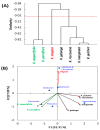Recent Advances in Kaempferia Phytochemistry and Biological Activity: A Comprehensive Review
- PMID: 31591364
- PMCID: PMC6836233
- DOI: 10.3390/nu11102396
Recent Advances in Kaempferia Phytochemistry and Biological Activity: A Comprehensive Review
Abstract
Background: Plants belonging to the genus Kaempferia (family: Zingiberaceae) are distributed in Asia, especially in the southeast region, and Thailand. They have been widely used in traditional medicines to cure metabolic disorders, inflammation, urinary tract infections, fevers, coughs, hypertension, erectile dysfunction, abdominal and gastrointestinal ailments, asthma, wounds, rheumatism, epilepsy, and skin diseases.
Objective: Herein, we reported a comprehensive review, including the traditional applications, biological and pharmacological advances, and phytochemical constituents of Kaempheria species from 1972 up to early 2019.
Materials and methods: All the information and reported studies concerning Kaempheria plants were summarized from library and digital databases (e.g., Google Scholar, Sci-finder, PubMed, Springer, Elsevier, MDPI, Web of Science, etc.). The correlation between the Kaempheria species was evaluated via principal component analysis (PCA) and agglomerative hierarchical clustering (AHC), based on the main chemical classes of compounds.
Results: Approximately 141 chemical constituents have been isolated and reported from Kaempferia species, such as isopimarane, abietane, labdane and clerodane diterpenoids, flavonoids, phenolic acids, phenyl-heptanoids, curcuminoids, tetrahydropyrano-phenolic, and steroids. A probable biosynthesis pathway for the isopimaradiene skeleton is illustrated. In addition, 15 main documented components of volatile oils of Kaempheria were summarized. Biological activities including anticancer, anti-inflammatory, antimicrobial, anticholinesterase, antioxidant, anti-obesity-induced dermatopathy, wound healing, neuroprotective, anti-allergenic, and anti-nociceptive were demonstrated.
Conclusions: Up to date, significant advances in phytochemical and pharmacological studies of different Kaempheria species have been witnessed. So, the traditional uses of these plants have been clarified via modern in vitro and in vivo biological studies. In addition, these traditional uses and reported biological results could be correlated via the chemical characterization of these plants. All these data will support the biologists in the elucidation of the biological mechanisms of these plants.
Keywords: Kaempferia; biosynthesis; diterpenoids; flavonoids; phenolic; traditional medicine.
Conflict of interest statement
The authors declare no conflict of interest.
Figures




References
-
- Vinceti B., Loo J., Gaisberger H., van Zonneveld M.J., Schueler S., Konrad H., Kadu C.A., Geburek T. Conservation priorities for Prunus africana defined with the aid of spatial analysis of genetic data and climatic variables. PLoS ONE. 2013;8:e59987. doi: 10.1371/journal.pone.0059987. - DOI - PMC - PubMed
-
- Pérez-Sánchez R., Gálvez C., Ubera J.L. Bioclimatic influence on essential oil composition in South Iberian Peninsular populations of Thymus zygis. J. Essent. Oil Res. 2012;24:71–81. doi: 10.1080/10412905.2012.646025. - DOI
-
- Elshamy A., Mohamed T.A., Al-Rowaily S.L., Abd El-Gawad A.M., Dar B.A., Shahat A.A., Hegazy M.F. Euphosantianane E–G: Three new premyrsinane type 2 diterpenoids from Euphorbia sanctae-catharinae with 3 contribution to chemotaxonomy. Molecules. 2019;24:2412. doi: 10.3390/molecules24132412. - DOI - PMC - PubMed
Publication types
MeSH terms
Substances
LinkOut - more resources
Full Text Sources
Medical

